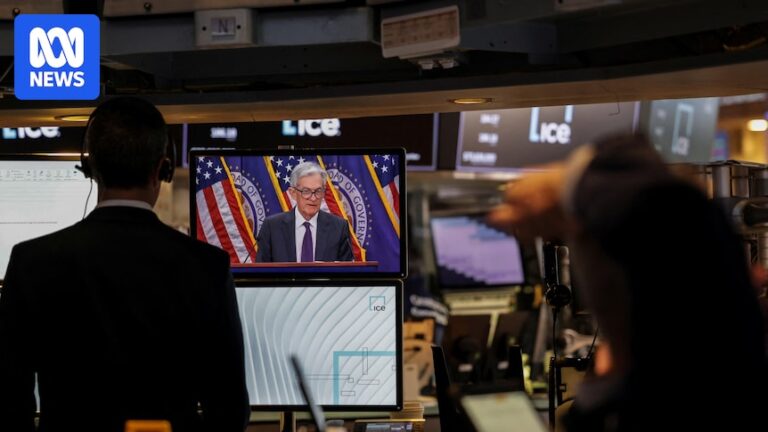Market snapshot
Prices current around 10:50am AEST
Live updates on the major ASX indices:
4m agoThu 31 Jul 2025 at 4:45am
De minimis exemption axed entirely by Trump
Here’s some Trump news you might have missed today.
The US President has suspended the so-called “de minimis” exemption that allowed packages worth less than $US800 to get into the United States without tariffs.
The exemption has already been axed on shipments going into the US from China, impacting massive online retailers like Shein and Temu.
Now the rest of the world’s shipments won’t get the free pass from July 1 either. They will now get one of two types of tariffs, depending on their origin.
ABC News has reached out to several Australian brands that ship into the US. The owner of one swimwear company, Bond Eye, told us it “knew this was coming” and the company has already moved to its online shipping logistics to inside the US.
If you’re still confused by this tax exemption that’s now ended for all brands going into the US, I can recommend this piece by our colleague Kate Ainsworth from earlier this year.
Here’s some of Kate’s explanation:
It operates the same as a duty-free allowance, but it has a more complex-sounding name: the de minimis exemption.
The loophole had been publicly questioned long before Mr Trump’s inauguration, with the Biden administration announcing last September that it was looking to take action against the volume of de minimis shipments arriving in the country.
At the time, the Biden administration said the actions were about addressing the “significant increased abuse of the de minimis exemption”, with a focus on Chinese-founded e-commerce platforms, such as Shein and Temu.
Data released by the US Customs and Border Protection Agency last November illustrated how big of a problem de minimis shipments had become in the country.
In 2024, the agency estimated it processed more than 4 million de minimis shipments into the US on a daily basis — more than double the volume it had processed in 2021 — with Shein and Temu accounting for more than 30 per cent of the total packages.
Housing approval rebound still well short of government target, warns HIA
The Housing Industry Association has welcomed the latest Australian Bureau of Statistics figures showing a jump in dwelling approvals, not only last month but over the 2024-25 financial year.
“New home building approvals in the 2024-25 financial year were up by 13.9 per cent compared to their 2023-24 trough,” notes HIA senior economist Tom Devitt.
“Detached house approvals increased by 6.1 per cent in the financial year, while multi-unit approvals were up by 27.9 per cent.
“Strong population growth, tight labour markets and recovering household incomes helped improve confidence in an increasing number of markets over the last 18 months, led by Western Australia, Queensland and South Australia.”
While he expects the positive trend to continue with another increase in 2025-26, Mr Devitt fears it will still fall short of the number of homes the federal government is targeting to address a shortfall in supply relative to population growth.
“Interest rate cuts from the Reserve Bank in February and May this year, with the expectation of more to come, will help bring more potential homebuyers back to the market in the lagging — and often more expensive — states and territories,” the economist forecasts.
“The challenge will be turning this modest improvement in conditions into the kind of recovery that will meet the Australian government target of 1.2 million homes over five years.
“In the 2024-25 financial year, the first year of the government’s five-year target, Australia approved just 187,330 new homes. Given that some approved projects don’t ever commence construction, the goal of commencing 240,000 homes per year remains a distant goal.
“Even with lower interest rates, Australia is set to start just 200,000 homes per year, on average, over the next four years.”
Treasurer assumes US tariff on Australia will remain 10pc
Despite US President Donald Trump hinting that the so-called “baseline” tariff applied to all countries will rise from the 10% announced on April 2 to 15-20%, Australia’s Treasurer Jim Chalmers is still working on the assumption this won’t happen.
“Our assumption and our understanding is that we’ve got the 10%, which is the lowest in the world,” he told reporters at a doorstop interview.
“Obviously, we’re aware of comments that have been made about that by President Trump, as well as comments made about tariffs on India and other developments this week.
“We’ll continue to work with the Americans to engage with them in our usual methodical, considered way to speak up for and stand up for Australian industries and Australian workers. That’s been our approach all along and that will continue to be our approach.”
We won’t have to wait too long to find out, with the US President expected to hold a press conference about 6am AEST tomorrow to announce tariff rates going forward.
That’s none too early — the temporary suspension of the April 2 “Liberation Day” tariffs ends at 2:01pm AEST tomorrow, and new executive orders must be signed before then, otherwise the tariff rates announced on that day will take effect again.
32m agoThu 31 Jul 2025 at 4:16am
Latest Chinese economic data a ‘worry’
China’s economy has been in need of a new growth driver for years.
The long-term plan has been to shift away from property and construction and into a consumer-led growth model.
But, like any other country, manufacturing remains the economic backbone of the world’s second-largest economy.
China’s manufacturing activity shrank for a fourth straight month in July, an official survey showed.
It points to weaker domestic demand and export growth.
James Wilson from Jamieson Coote Bonds described it as a “sluggish start” to third-quarter economic growth.
“Chinese factory activity hit a three-month low in signs of weaker exports and also domestic demand.”
“It’s a sluggish start to the third quarter
“It’s a little bit of a worry going forward as the economy has broadly held up OK in the face of tariffs, however, this may have been helped along by front-loading from exporters,” he said.
BHP Group was down over 2 per cent and Rio Tinto had lost 3 per cent at 2pm AEST.
1h agoThu 31 Jul 2025 at 3:21am
Iron ore prices fall as China demand fears continue
The market price of one of Australia’s biggest exports is falling, as fears of falling demand in China continue.
This in from Reuters:
Iron ore futures prices declined for a second straight session on Thursday, as weaker-than-expected July factory activity data in top consumer China raised demand concerns.
The most-traded September iron ore contract on China’s Dalian Commodity Exchange (DCE) DCIOcv1 traded 1.44% lower at 786.5 yuan a metric ton, as of 0230 GMT.
The benchmark September iron ore SZZFU5 on the Singapore Exchange was 0.75% lower at $100.95 a ton, as of 0220 GMT.
China’s manufacturing activity shrank for a fourth straight month in July, an official survey showed Thursday, suggesting a surge in exports ahead of higher U.S. tariffs has started to fade while domestic demand remained sluggish.
Prices of the key steelmaking ingredient softened on Wednesday after hopes faded that Beijing would unveil more stimulus measures at its July Politburo meeting that set the economic course for the remainder of the year.
1h agoThu 31 Jul 2025 at 3:17am
Student debts to be slashed as HECS bill passes Senate
Australians with student debts will have their HECS cut by 20 per cent after the government’s bill passed the Senate.
Education Minister Jason Clare said the bill, which passed with support from the Greens and some crossbenchers, is now guaranteed and will be backdated to June 1.
It will provide relief to those with outstanding HECS debts, who make compulsory repayments out of their income above a threshold.
Open the ABC News politics blog in a new tab to follow the latest:
1h agoThu 31 Jul 2025 at 2:50am
ASX slightly down in lunchtime trade
The ASX 200 is down almost 0.2% at lunchtime. The bottom stocks include oil and gas producers, like Beach Energy.
Any stock movements you’d like investigated today?
2h agoThu 31 Jul 2025 at 2:49am
Victims of fraud and DV being chased by ATO
This powerful story from our reporter Nassim Khadem today calls into question the powers and procedures of the tax office when chasing up business debts.
Do you have a tip-off for Nassim about this? You can email her on khadem.nassim@abc.net.au
2h agoThu 31 Jul 2025 at 2:27am
Australians seeking out bargains as cost pressures continue
So, a lot of bleating about how tough people are doing it and how interest rates MUST be lowered and yet a huge increase in retail spending. It would seem the RBA’s approach is (heaven forbid) based on data and not emotion, just as it should be.
– Bemused
Thanks for your comments!
It is worth noting these latest retail figures aren’t exactly booming, and the ABS notes they were pushed up by sales and end-of-financial-year incentives.
Australians do love an EOFY sale!
KPMG’s chief economist, Brendan Rynne, noted this effect, including purchases of winter clothing, as well as the release of new products, including a Nintendo Switch 2.
“As cost-of-living pressures continue, households are very much vying for bargains wherever they can, with sale items now consuming a far larger portion of our spending compared to just a few years ago,” Dr Rynne said in a note.
More from Steph’s reporting on this:
The 1.2 per cent rise in retail turnover in June follows a half per cent rise in May, and no change in April, according to the ABS.
Spending at the end of the financial year saw shoppers opening their wallets.
“The strong June month rise in retail turnover was driven by discounts linked to sales and new product releases,” ABS head of business statistics Robert Ewing said.
“After steady growth throughout the year, mid-year sales events increased spending on discretionary items like furniture, electrical goods and clothing items.”
So will this stop the RBA cutting in August? This note from Capital Economics doesn’t think so.
The solid pickup in retail sales in June doesn’t detract from the fact that goods spending across Q2 was rather lacklustre. That being the case, the data won’t stand in the way of the RBA cutting rates by 25bp at its meeting in two weeks’ time.
Eggs to coffee: Why food inflation is still a problem
Yesterday I went down to a fresh produce market in Melbourne to chat to people about the latest quarterly inflation figures, which show price spikes are easing further.
Unsurprisingly, nobody seemed to be cheering at the checkout. Seems we all notice prices when they explode, but it’s a lot harder to notice easing inflation.
Lots of punters also noted ongoing spikes on some items. “Butter has been wild,” one keen cake baker noted to me.
It is worth noting that food inflation is still elevated, at 3% compared to 2.1% overall. And as Rabobank analyst notes, overall food inflation is still above the 10-year average.
Some of the items where spikes are continuing include eggs (+19.1%), coffee (+9.4%) and fresh lamb (+12.1%). These spikes are linked to environmental factors, including global drought and bird flu.
Cooking oils, cereal products and seafood are the only three categories posting price declines, Rabobank analysed.
As for butter? Rabobank notes that global butter prices are hovering near record levels, and that Australia is exposed because we are a net importer.
This doesn’t just have ramifications for household budgets and home bakers. It also flows through to the hospitality industry, which has been battling especially tough times.
As one cafe and restaurant owner told me, they’ve been reluctant to pass on higher costs like those coffee prices, because they’re worried about spooking price sensitive diners.
“The feeling right throughout hospitality is this tension between needing to keep the lights on, but also not wanting to alienate customers who are price sensitive right now,” Tresna Lee from Gemini told me.

The silver lining? Even the most hawkish of economists think that the overall lower inflation should prompt the RBA to cut rates in August again.
“The great hope is that lower interest rates will start to see consumer spending pick up,” economist David Bassanese says.
“Consumer spending has been constrained now for a few years, it’s certainly hurting many sectors — hospitality and retail sectors in particular.”
2h agoThu 31 Jul 2025 at 2:03am
New apartments keeping the housing industry afloat
The latest housing approvals show there’s been another dip in the demand for building for new houses, with approvals down 2% in June. Victoria was the only state where they went up.
But overall, total dwelling approvals are up, at their highest level since August 2022. And it’s because of apartments.
“It was a bumper month for private attached dwellings, up 33% to 7,594,” Timothy Hibbert from Oxford Economics Australia, just wrote in a note.
That follows a 10.3% rise in May.
“A surge in Sydney apartment approvals backed this result,” Mr Hibbert continues.
“Our project tracking suggests density bonuses for developments providing affordable stock in the state are impacting as intended in drawing out apartment developments. Queensland posted a less spectacular, but still very solid uplift.”
Some analysts have been noting in recent months that apartments are simply cheaper to build, especially during higher rates and with the property market so much more expensive to crack than several years ago.
ABS analyst Daniel Rossi also notes this today about the latest approval data:
“The average approval value for new private sector houses has continued to rise year-on-year, but has slowed during the 2024-25 financial year.
“The slowing average approval values for new houses is consistent with moderating building costs, as reflected in Producer Price Indexes.”
So what could happen next?
“With both employment and inflation indicators softening, we expect to see a rate cut in August, followed by another in Q4,” Mr Hibbert continues.
“Lower mortgage rates are already showing through in forward leads for new dwelling demand. Combined with other policy supports including increased funding in the social & affordable housing space, growth is geared to continue in financial year 2026.”
2h agoThu 31 Jul 2025 at 1:52am
Last retail trade data to be published by ABS
For all the loyalists of the retail trade dataset out there, it is with a heavy heart that I remind you that today is its final publication.
Here’s more from the ABS release:
Australian statistician David Gruen AO said: “Today’s final publication comes 74 years after Sir Roland Wilson, Chief Statistician at the time, released the results of the first Retail Trade survey in 1951.
“Sir Roland noted that total Australian retail sales in the September quarter of 1950 amounted to £383.2 million — around $20.5 billion in today’s dollars.”


“The ABS would like to thank the many businesses that have contributed over the 74 years of the Retail Business Survey,” Dr Gruen continued.
“After today’s publication, monthly statistics on household spending will be available in the ABS’ Monthly Household Spending Indicator (MHSI), providing a more comprehensive view of consumption, across both goods and services.”
Mid-year discounts see shoppers return: ABS
The 1.2 per cent rise in retail turnover in June follows a half per cent rise in May, and no change in April, according to the ABS.
Spending at the end of the financial year saw shoppers opening their wallets.
“The strong June month rise in retail turnover was driven by discounts linked to sales and new product releases,” ABS head of business statistics Robert Ewing said.
“After steady growth throughout the year, mid-year sales events increased spending on discretionary items like furniture, electrical goods and clothing items.”
He said consumers are targeting sales events with a focus on value for big-ticket items like household furniture, bedding, electronic devices and TVs.
“Turnover for electrical and gaming retailers was lifted further by the much-anticipated launch of the Nintendo Switch 2, which delivered record sales.”
Retail sales rise more than expected
The Bureau of Statistics has released retail sales data, and it’s come in stronger than expected.
Australian retail turnover rose 1.2 per cent in June, according to seasonally adjusted figures, compared to expectations for an 0.4 per cent increase, according to economists polled by Reuters.
3h agoThu 31 Jul 2025 at 1:30am
Key takeaways from RBA deputy governor Andrew Hauser’s ‘fireside chat’ — analysis
So, I’ve got back to the office now after attending the RBA deputy governor’s “fireside chat”.
Having had a couple of hours to digest what Andrew Hauser had to say, here are my thoughts on the key takeaways:
Inflation is tracking in line with RBA forecasts. RBA forecasts from May suggested inflation would be around the middle of the target, with the cash rate at 3.2% by early next year. That suggests to me that the RBA can cut the cash rate at least twice, and perhaps three times more.Unemployment isn’t high at 4.3%. The RBA is relaxed with where the jobs market is, so unless we see unemployment heading above 4.5%, I don’t think it’s going to see the bank accelerate rate cuts.We will (at least officially) remain in the dark about how individual RBA Monetary Policy Board members voted on rates, even though they will be giving their own speeches at least once a year. However, we may get hints about who is more “dovish” and “hawkish”. The RBA deputy, who came from the Bank of England, which does publish how members voted, thinks that system creates more problems than benefits.There is still scope for major surprises in the global economy, depending on where US tariffs end up and the response from other nations.
In summary, as I wrote in the headline of this article from May, interest rates could drop below 3%, but you probably don’t want them to.
I’m pretty sure Hauser, the RBA staff, and probably most board members would still broadly agree with that analysis.
4h agoThu 31 Jul 2025 at 12:49am
Flight Centre downgrade disappoints
Analysts and investors have taken a negative view on Flight Centre’s latest update, which saw it lower its profit guidance.
“While current softness in the travel market is well known to investors, we believe another FY25 downgrade, one month after balance date, will negatively surprise the market,” RBC Capital Markets analyst Wei-Weng Chen noted.
And they were proven correct, with the stock off 7.9 per cent at the moment.
Mr Chen said the downgrade puts the middle of Flight Centre’s most recent guidance 25 per cent below its original guidance provided last November. And certainly a lot has changed in that time for global relations and the fallout for travel.
4h agoThu 31 Jul 2025 at 12:43am
Beach Energy falls on $674 million impairment hit
Beach Energy is the worst-performing stock on the benchmark index so far, down 9.9 per cent.
The company released its quarterly production report, with full-year production up 9 per cent and sales revenue up 13 per cent.
Underlying earnings and profit were also higher.
However, Beach flagged a non-cash impairment charge of $674 million that will be recorded in its results for the last financial year, “related predominantly to lower commodity price outlook”.
Its results will be released this coming Monday, August 4.
Australian shares open lower as tariff deadline looms
Most sectors on the local market remain in the red 20 minutes into the session, while the ASX 200 is currently down half a per cent overall.

Flight Centre shares are down 7.2 per cent after it lowered its profit guidance.
Miners are also a major drag, led by a 7.8 per cent fall for Mineral Resources. Beach Energy shares are off 10.9 per cent, weighing on the energy sector.
ASX opening in the red
It’s very early days as stocks are just coming online, but we currently have the ASX 200 down 0.6 per cent.



